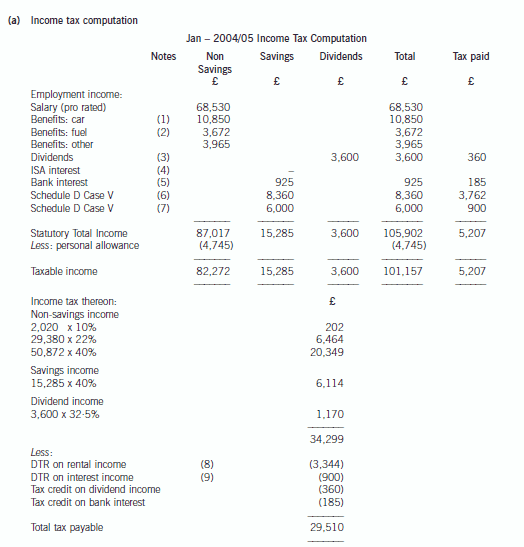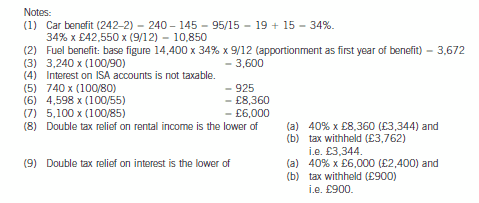2020年ACCA考试SBR科目考点清单
发布时间:2020-03-13
SBR科目是原来的P2科目,也就是专业阶段的第二门课程,其课程名称为Strategic Business Reporting,即战略业务报告,这一科目会涉及到报表的编制。那么,这一科目又有哪些考点呢?下面,51题库考试学习网为大家带来ACCA考试中SBR科目考点的相关信息,以供参考。
从内容上看,SBR与以前的P2相比,在内容上并无大的改动,这一门课核心内容是掌握IAS及IFRS国际准则的要求和会计处理方法。因此,我们在学习这一部分内容时,需要理解每一项会计处理地原理,掌握其处理方法,并不断加以练习和总结。在学习时,考生最好以练习为主,记忆为辅。
以上就是关于ACCA考试中SBR科目考点的相关情况。51题库考试学习网提醒:SBR科目对考生的分析能力要求比较高,因此小伙伴们可以通过多做练习题,来提升自己的分析、总结能力。最后,51题库考试学习网预祝准备参加2020年ACCA考试的小伙伴都能顺利通过。
下面小编为大家准备了 ACCA考试 的相关考题,供大家学习参考。
2 Assume that today’s date is 1 July 2005.
Jan is aged 45 and single. He is of Danish domicile but has been working in the United Kingdom since 1 May 2004
and intends to remain in the UK for the medium to long term. Although Jan worked briefly in the UK in 1986, he
has forgotten how UK taxation works and needs some assistance before preparing his UK income tax return.
Jan’s salary from 1 May 2004 was £74,760 per annum. Jan also has a company car – a Jaguar XJ8 with a list price
of £42,550 including extras, and CO2 emissions of 242g/km. The car was available to him from 1 July 2004. Free
petrol is provided by the company. Jan has other taxable benefits amounting to £3,965.
Jan’s other 2004/05 income comprises:
£
Dividend income from UK companies (cash received) 3,240
Interest received on an ISA account 230
Interest received on a UK bank account 740
Interest remitted from an offshore account (net of 15% withholding tax) 5,100
Income remitted from a villa in Portugal (net of 45% withholding tax) 4,598
The total interest arising on the offshore account was £9,000 (gross). In addition, Jan has not remitted other
Portuguese rental income arising in the year, totalling a further £1,500 (gross).
Jan informs you that his employer is thinking of providing him with rented accommodation while he looks for a house
to buy. The accommodation would be a two bedroom flat, valued at £155,000 with an annual value of £6,000. It
would be made available from 6 August 2005. The company will pay the rent of £600 per month for the first six
months. All other bills will be paid by Jan.
Jan also informs you that he has 25,000 ordinary shares in Gilet Ltd (‘Gilet’), an unquoted UK trading company. He
has held these shares since August 1986 when he bought 2,500 shares at £4.07 per share. In January 1994, a
bonus issue gave each shareholder nine shares for each ordinary share held. In the last week all Gilet’s shareholders
have received an offer from Jumper plc (‘Jumper’) who wishes to acquire the shares. Jumper has offered the following:
– 3 shares in Jumper (currently trading at £3.55 per share) for every 5 shares in Gilet, and
– 25p cash per share
Required:
(a) Calculate Jan’s 2004/05 income tax (IT) payable. (11 marks)


(ii) Identify and explain the potential financial statement risks caused by the breach of planning regulations
discussed in the press cutting. (6 marks)
(ii) Several significant financial statement risks are indicated by the press cutting.
Overstatement of property, plant and equipment
Medix Co has constructed a research laboratory which is likely to be impaired at the year end. The local authority has
the power to shut down the facility, and it is clear from the press cutting that this is likely to happen before the year end.
Following IAS 36 Impairment of Assets, the premises should be written down to recoverable amount, and the
impairment loss recognised as an expense. The directors should carry out an impairment review before the year end. If
the premises cannot be used as intended then the recoverable amount (measured using the higher of value in use and
fair value less selling cost) is likely to be less than current carrying value. In this case, assuming the local authority is
successful in shutting down the research laboratory, the recoverable amount is likely to be nil, as the premises have no
value in use, as it will never be used commercially, and has no market value as it is likely to be demolished.
In addition, any tangible assets such as laboratory equipment located at the premises should be tested for impairment
as if the company cannot use the premises then the assets contained within it are likely to have a lower recoverable
amount than carrying value.
Contingency – fines or penalties imposed by local authority
The press cutting indicates that Medix Co has been sued before, and that the local authority may again take legal action
against the company. IAS 37 Provisions, Contingent Liabilities and Contingent Assets states that a provision should be
recognised if the company has a probable obligation at the year end which can be measured reliably. If payment is
deemed only possible at the year end, then disclosure of the contingent liability should be made in a note to the financial
statements.
If the local authority commences legal proceedings against Medix Co before the year end of 30 June 2008, then
management should assess the probability of payment. The financial statement risk is not recognising a provision (and
associated expense within the income statement), or not disclosing a contingency.
Demolition costs
The local authority may require Medix Co to demolish the premises. If this demand is made before the year end, Medix
Co should recognise a provision for demolition costs as an unavoidable legal obligation would have been created. The
financial statement risk is that in this situation, Medix Co fails to recognise a provision and associated expense within
the income statement.
Going concern
The above issues could indicate that the company may not continue in operational existence. The potential lack of
disclosure of these issues represents a financial statement risk.
3 Clyde Williams is facing a dilemma. He has successfully built up a small family-owned company, Concrete Solutions
Ltd, manufacturing a range of concrete based products used in making roads, pavements and walkways. The
production technology is very low tech and uses simple wooden moulds into which the concrete is poured. As a
consequence he is able to use low skilled and low cost labour, which would find it difficult to find alternative
employment in a region with high unemployment levels. The company has employed many of its workforce since its
creation in 1996. The company’s products are heavy, bulky and costly to transport. This means its market is limited
to a 30-mile area around the small rural town where the manufacturing facility is located. Its customers are a mix of
private sector building firms and public sector local councils responsible for maintaining roads and pavements. By its
nature much of the demand is seasonal and very price sensitive.
A large international civil engineering company has recently approached Clyde with an opportunity to become a
supplier of concrete blocks used in a sophisticated system for preventing coast and riverbank erosion. The process
involves interlocking blocks being placed on a durable textile base. Recent trends in global warming and pressure in
many countries to build in areas liable to flooding have created a growing international market for the patented erosion
prevention system. Clyde has the opportunity to become the sole UK supplier of the blocks and to be one of a small
number of suppliers able to export the blocks to Europe. To do it he will need to invest a significant amount in CAM
(computer aided manufacturing) technology with a linked investment in the workforce skills needed to operate the
new technology. The net result will be a small increase in the size of the labour force but redundancy for a significant
number of its existing workers either unwilling or unable to adapt to the demands of the new technology. Successful
entry into this new market will reduce his reliance on the seasonal low margin concrete products he currently produces
and significantly improve profitability.
One further complication exists. Concrete Solutions is located in a quiet residential area of its home town. Clyde is
under constant pressure from the local residents and their council representatives to reduce the amount of noise and
dust created in the production process. Any move into making the new blocks will increase the pollution problems
the residents face. There is a possibility of moving the whole manufacturing process to a site on a new industrial estate
being built by the council in a rival town. However closure of the existing site would lead to a loss of jobs in the current
location. Clyde has asked for your help in resolving his dilemma.
Required:
(a) Using models where appropriate, advise Clyde on whether he should choose to take advantage of the
opportunity offered by the international company. (12 marks)

SWOT analysis, including his personal liability to manage the strategic change would be useful. There may be a significant
investment in new technology and employee training to make the new blocks. In effect he will be forming a strategic alliance
with the international company and making significant changes to both the value chain and value system. There will be no
need to invest in sales and marketing as this will be the responsibility of its larger partner. As a major strategic option there
is a need to address issues of its suitability, acceptability and feasibility. In terms of suitability the option seems to address
many of the strategic problems attached to his current product range. It is a product that can be sold all year round and into
a much wider geographical market area. It is in terms of acceptability that the dilemma reveals itself and the impact on the
different stakeholders involved – he may find stakeholder mapping and scenario building useful in coming to a decision. As
the owner of the business he needs to assess the risk involved against the likely returns. Feasibility looks reasonably sound– new resources and skills will be needed but affordable and achievable with the support of the partner.
声明:本文内容由互联网用户自发贡献自行上传,本网站不拥有所有权,未作人工编辑处理,也不承担相关法律责任。如果您发现有涉嫌版权的内容,欢迎发送邮件至:contact@51tk.com 进行举报,并提供相关证据,工作人员会在5个工作日内联系你,一经查实,本站将立刻删除涉嫌侵权内容。
- 2020-03-01
- 2020-03-13
- 2020-03-14
- 2020-01-03
- 2020-08-07
- 2021-05-23
- 2020-01-03
- 2020-08-15
- 2019-07-19
- 2020-03-12
- 2020-03-13
- 2020-05-20
- 2020-08-07
- 2021-06-19
- 2020-03-12
- 2019-07-19
- 2020-03-13
- 2019-07-19
- 2019-07-19
- 2021-05-02
- 2021-06-19
- 2020-03-08
- 2020-01-02
- 2020-03-13
- 2019-07-19
- 2019-07-19
- 2020-03-01
- 2019-07-19
- 2019-07-19
- 2020-01-02